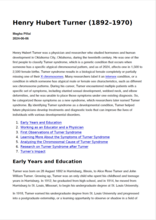Filter my results


In 1962 researcher John Bertrand Gurdon at the University of Oxford in Oxford, England, conducted a series of experiments on the developmental…
Cell nuclei--TransplantationGenetic EngineeringNuclear TransplantationUniversity College (University of Oxford)Xenopus laevis
Henry Hubert Turner was a physician and researcher who studied hormones and human development in Oklahoma City, Oklahoma, during the twentieth…
Turner SyndromeNoonan SyndromeKlippel-Feil SyndromeEndocrine System DiseasesEndocrine Glands
The principal work of St. Thomas Aquinas, the Summa Theologica is divided into three parts and is designed to instruct both beginners and experts in…
LiteratureThomas, Aquinas, Saint, 1225?-1274religionCatholicismHuman Development
Joseph Needham was an embryologist and biochemist who is most noted in science for his studies on induction in developing embryos. Needham worked…
PeopleEmbryonic InductionBiography
Telomerase is an enzyme that regulates the lengths of telomeres in the cells of many organisms, and in humans it begins to function int the early…
TelomeraseTelomereDNAMolecular BiologySomatic embryogenesis
On 20 January 2001, Republican George W. Bush was sworn in as the forty-third president of the United States, replacing Democrat William J. Clinton.…
LawBush, George W. (George Walker), 1946-Stem CellsFetus
The spinal column is the central structure in the vertebrate body from which stability, movement, and posture all derive. The vertebrae of the spine…
Congenital, Hereditary, and Neonatal Diseases and AbnormalitiesReproductionVertebratesCongenital Disorders
Environment and Birth Defects by James Graves Wilson in the US was published in 1973. The book summarized information on the causes of malformations…
LiteratureBirth DefectsAbnormalities, HumanTeratogensTeratology
No-scalpel vasectomy, or NSV or keyhole vasectomy, is a surgical method of sterilization that involves puncturing the skin of the scrotum to access…
TechnologySterilizationVasectomyMale SterilizationFamily Planning
In 1953, Raymond Greene and Katharina Dalton, who were doctors in the UK, published The Premenstrual Syndrome in the British Medical Journal. In…
LiteraturePremenstrual syndromeMigraineMenstruationMenstruation disorders